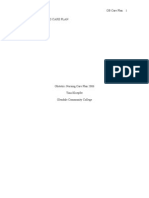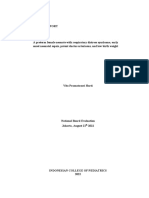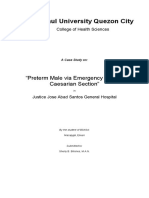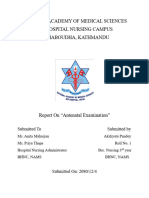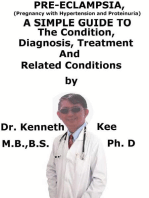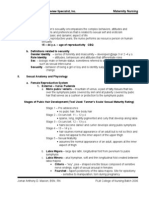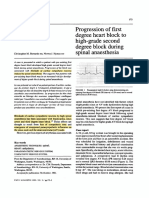Obstetric Nursing Care Plan
Obstetric Nursing Care Plan
Uploaded by
fiercesheCopyright:
Available Formats
Obstetric Nursing Care Plan
Obstetric Nursing Care Plan
Uploaded by
fiercesheOriginal Title
Copyright
Available Formats
Share this document
Did you find this document useful?
Is this content inappropriate?
Copyright:
Available Formats
Obstetric Nursing Care Plan
Obstetric Nursing Care Plan
Uploaded by
fiercesheCopyright:
Available Formats
11g1h1t1 121p1m OBSTETRIC NURSING CARE PLAN
Obstetric Nursing Care Plan 2006 Tina Kloepfer Glendale Community College
22g2h2t2 222p2m Patient Profile G.B. is an intelligent, confident, 5 feet and 4 inches tall, ABO B+, 28-year-old Caucasian female patient: G1P1, LMP is February 2, 2006, EDC is November 18, 2006 and gestation of 396/7 weeks confirmed by an ultrasound per chart. Pre-pregnancy weight was 137 lbs and pregnancy weight is 174 lbs for a total gain of 37 pounds. G.B. stated she eats a semi-strict vegetarian diet (no dairy, no red meat), rarely drinks alcohol (no alcohol while pregnant), and she has never smoked cigarettes or taken recreational drugs. Prenatal labs are negative. G.B. was admitted to GAMC after an attempted home birth via midwife assistance with intact membranes at 0710 hrs on November 16, 2006. The patient stated her cervix dilated to only 3 cm after laboring over 24 hours at home. G.B. stated she prepared for labor and delivery by learning the Bradley method and she hired a doula for the postpartum period. G.B. plans on breastfeeding her neonate for at least 1 year. She is allergic to penicillin, amoxicillin, and erythromycin. Significant medical history includes systemic lupus erythematosus (SLE), past positive PPD and negative xray within last 5 years, and adenomyosis (endometriosis interna) via laparoscopy in 2002 per chart. No significant family medical history. G.B.s supportive, caring, and protective husband was at bedside throughout the labor and delivery and postpartum. IV Lactated Ringers 1000 mL at 125 mL/hr and external fetal monitoring was initiated shortly after admission. Throughout the labor phases, there were several accelerations, but no late decelerations of the FHR per chart. G.B. was placed on continuous epidural of Fentanyl, 0.2% Noropin and 0.25% Marcaine at 14 mL/hr for pain at 4 cm dilation. A stress dose of 100 mg of hydrocortisone was given IM at 5 cm dilation. An AROM was performed at 1815hrs resulting in clear amniotic fluid and negative meconium stain. The fetus was in vertex presentation and LOA position. A right mediolateral 2 episiotomy was performed before a normal spontaneous vaginal delivery without maneuvers or complications. A healthy male neonate was delivered at 0054hrs on November 17, 2006: birth weight 3203 gr (7.1 oz), length 51 cm (21 in) and APGARs 81 and 95. The umbilical cord had 2 arteries and 1 vein. The placenta was delivered intact and spontaneously with minimal assistance. Estimated maternal blood loss was 200 mL. After bulb suctioning, the newborn was transferred to the nursery. The mother and newborn bonded very well after birth per chart. G.B.s IV in her left forearm and Foley catheter were immediately discontinued per the patients request. The parents refused PKU and signed a state refusal form. The parents also denied the initial bath, eyes and thighs (erythromycin eye ointment and Vitamin K injection), and hospital photographs of the newborn per chart. The parents are allowing a hearing test to be conducted in the afternoon per patient. According to the night RN, no one has visited with the new parents yet, but the mother-in-law is coming to visit in the afternoon to allow the husband to rest per the patient. Assessment Subjective Data: The patient complains of feeling slightly dizzy while sitting, an increase of dizziness upon standing, and she is experiencing tinnitus whistling, ringing and loud whooshing like a jet engine in her ears bilaterally. The patient denies history of tinnitus, balance problems, or syncope. Pain scale is 3/10 in uteral and perineal areas. The patient stated she has not yet experienced any flatulence after the birth of her son. G.B. stated she
33g3h3t3 323p3m already experiences the letdown (milk ejection) reflex whenever her son cries and he breastfeeds often and heartily. Objective Data: Prior to my assessment, the mother was gazing, smiling, and talking softly to her newborn and seemed slightly reluctant to give the newborn to the father in order for me to perform an assessment. The father looks tired as he holds the newborn closely and fondly. The father smiles at his son when he opens his eyes and excitedly informs his wife. The patients vital signs are WNL: oral temperature is 36.8C (98.2F), apical pulse is 60, respirations are 20, and blood pressure is 110/60. Lung sounds are clear bilaterally. The trachea is midline, respirations are regular and symmetrical on room air, and there is no use of accessory muscles. S1 and S2 are present, rhythm is regular and there are no murmurs, clicks, thrills, or heaves. Radial, femoral, popliteal, pedal pulses are 2+ bilaterally and cap refill <3 seconds on all digits. Skin is slightly pale, warm, and dry. No edema in the lower extremities bilaterally. BUBBLE-HE: Breasts are semi-soft, non-tender without any erythema or areas of increased warmth. Nipples are not inverted bilaterally. The fundus of the uterus is firm, centered, and located 1.5 finger breadths below the umbilicus. Facial grimacing and furrowed brows occur upon brief, gentle palpation of fundus. The bladder is not distended or palpable. G.B. has voided a total of 450 ml of clear, yellow urine this morning. The last bowel movement was November 16, 2006 per patient. Bowel sounds are hypoactive in all 4 quadrants. Abdomen is soft, non-tender, and rounded. Lochia rubra is scant, without clots or odor. RML 2 episiotomy is intact without erythema or edema. There are no visible hemorrhoids. Homans sign is negative bilaterally. Upon gentle palpation bilaterally of the posterior lower extremities, there are no areas of warmth, tenderness or swelling. Emotional issues are G.B.s deep, deep desire to control her environment and the disappointment of not adhering to her well-researched birthing plan. The patient is bonding very well to her newborn and enjoys watching her husband bond with their newborn too. Pertinent Labs Laboratory11/17/2006 0950hrs11/16/2006 0700hrsBefore / During Pregnancy MS Text HematologyWBCH 20.2H 11.94.5-10 / 5-15HGBL 10.8 12.710-14 / 12-16 HCTL 32.5 37.037-47 % / 32-42 %RBC, MCV, MCH, MCHC, RDW, PLT, PLT Est., MPV WNLDifferential TypeNeuts %H 83*3-7Lymphs %L 1238-46 % / 15-40 %Abs Neut Count H 9.877*1.5-8Bands%, Monos%, Eos%, Basos%, Abs Eos Ct, Nucleated RBCs, RBC Morph WNLChemistryChlorideH 108*96106Random GlucoseH 170*60-110BUN/Creatinine RatioL 10.0*10:1-20:1CalciumL 7.7*8.8-10.4Sodium, Potassium, CO2, Anion Gap, BUN, Creatinine, GFR WNLBlood BankBand Pt, Hold Tube in Blood BankDrawn @ 2311hrs*Fischbachs Lab & Diagnostic Book Values for Adult Norms Lab Results: Neutrophilia observed during labor and early postpartum is caused by the physiologic response to the stress of labor and delivery (London, Ladewig, Ball & Bindler, 2007). Lymphopenia can occur in SLE and long-term hydrocortisone therapy (Fischbach, 2004). Low hemoglobin and hematocrit (H&H) can reflect the condition of physiologic or relative anemia due to blood loss during delivery (London, et. al., 2007).
44g4h4t4 424p4m High chloride levels can be caused by dehydration and long term hydrocortisone therapy (Mann, D. and Chang, L., 2006). The patient requested to discontinue her IV post delivery which probably contributed to a dehydrated state. Hyperglycemia can cause glucosuria which causes an increase in urine output (Fischbach, 2004) and can result from being pregnant (slight elevation) and long-term hydrocortisone therapy. SLE required a stress dose of 100 mg hydrocortisone IM before delivery per chart. The patients dizziness may be also related to hyperglycemia (Fischbach, 2004). Decreased BUN/creatinine ratio can be caused by the state of pregnancy and a low-protein diet (Fischbach, 2004). Low calcium levels can be caused by not receiving enough calcium in the diet (Fischbach, 2004). Achievement of Eriksons Developmental Tasks Intimacy vs. Isolation [18-40 yrs]: G.B. is basking in the wonder of her first newborn and handles her son with such care, concern, protection, and love. She holds him close and softly sings and talks to him as she caresses his back and the tuft of hair on his head. The newborn reciprocates sustained eye contact with his mother. G.B. and her husband admire their newborn together as a couple and solo as a proud parent. The patient stated her husband had not slept in over 30 hours. G.B. stated her husband would not go home unless someone could be with her and their son. G.B. stated she is going to call her mother-in-law to come to the hospital this afternoon in order for her husband to finally go home and rest. Problem Identification HUMAN NEEDS - Level 5 Esteem and Recognition: The patient stated she feels extremely disappointed that she did not deliver her son at home as she and her husband had planned. I feel like I didnt do something right somehowlike it is somehow my fault were here [in the hospital]. I know the L&D nurses thought I was a pain in the ass and possibly an idiot because I didnt want them to wash my son, but I wanted to continue our bonding experience. I just couldnt give him up even for a little while. PHYSIOLOGICAL NEEDS Level 1: Pain Avoidance (Postpartum 3/10 - mild pain), Oxygenation/Perfusion (dizziness, blood loss, physiologic anemia), Hydration (unsatisfactory PO intake of fluid, refusal of IV fluids, hyperglycemia), and Rest (exhaustion from L&D). Level 2: Activity (dizziness requires assistance and/or bed rest), and Cognitive & Perceptual (dizziness, tinnitus). Primary Nursing Diagnosis Disturbed Auditory Sensory Perception related to physiological stress from labor and delivery and SLE manifested by dizziness and whistling, ringing and whooshing like a jet engine in the ears bilaterally (Ackley & Ladwig, 2006 and Mann, D. and Chang, L. MD, 2006). GOALS 1. The patient will report relief of symptoms by using the 10/10 scale from the current ranking of 9/10 to an acceptable 4/10 by the end of shift. 2. The patient will demonstrate understanding of coping methods by the end of shift. INTERVENTIONS 1. Assess the characteristics of the dizziness and the type, intensity, duration, and frequency of the bothersome noises heard by the patient.
55g5h5t5 525p5m The patients description of the characteristics of the dizziness and noises can help to determine the course of nursing actions taken to treat the causes and alleviate the patients symptoms (Information on tinnitus, 2000). 2. Encourage good communication by speaking distinctly and facing the patient when speaking to her. Good communication increases the chances of good outcomes and increases patients morale and satisfaction with her medical care. 3. Instruct the patient to ask for assistance to walk to the bathroom. If the dizziness is severe, instruct the patient to call for assistance to use the bedpan. The patients safety is maintained and the risk for falls is decreased. 4. Consult with the physician to monitor the patients blood glucose and utilize a sliding scale for insulin coverage. Patients on long-term steroid therapy often develop increased blood glucose levels especially when under physiological stress. Hyperglycemia can cause dizziness (Mann, D. and Chang, L., 2006). 5. Encourage a high intake of fluids and nutrition. Oral fluid intake increases the blood volume and decreases dehydration after blood loss and refusal of intravenous fluids. Dizziness is a symptom of dehydration. Good nutrition will decrease fatigue, aid in stabilizing blood sugar levels, and increase energy levels depleted by physiologic anemia. (London, et.al., 2007). 6. Encourage the patient to take a nap whenever her son sleeps. The new mother needs to sleep to decrease fatigue and to conserve energy. Fatigue can contribute to the severity of her symptoms (London, et.al., 2007). 7. Teach and encourage the patient to use visual relaxation and concentration exercises. The increased relaxation and circulation achieved by these exercises may reduce any anxiety and the intensity of the whistling and ringing heard by the patient (Information on tinnitus, 2000). 8. Encourage the use of masking by choosing a competing sound. Choosing a sound such as radio static (white noise) played at a constant low level competes with the bothersome sounds. The competition makes the bothersome ringing and whistling sounds less noticeable (Information on tinnitus, 2000). EVALUATION 1. Goal partially met: The patient rated her discomfort level as 6/10 by the end of shift. The patients symptoms were assessed. I reported my findings to the RN and she said, Well wait to see if oral fluids decrease her symptoms. I respectfully asked if we could monitor her blood sugar (170 after breakfast) and consult with the physician to order a sliding scale of insulin for coverage and the RN replied, Lets just wait and see. The patient increased her PO fluid intake. Urine output remained clear and straw colored. The patient stated the dizziness decreased some what from this mornings assessment, but she still experiences low-moderate dizziness. G.B. allowed herself to take only two naps while her son slept during the shift.
66g6h6t6 626p6m 2. Goal met: The patient verbally and physically demonstrated an understanding of the coping methods by the end of shift. The patient asked for assistance to use the bedpan during a severe dizzy spell and she asked for assistance each time she walked to the toilet. The patient experienced a slight decrease of the whistling and ringing in her ears by performing relaxation exercises and her daily meditation. G.B. called her mother-inlaw to ask her to bring a radio when she came to relieve the husband in the afINDX(6 6l/666666666666(666X 666666666~6}6666666 r666666666O_6666x6d66666>_66667 ~ 7 60H66666@/H66666 6666666 1606o6u6t6o6f61606 626p6m6.6m6p6366666O_6666p6Z66666>_66667 -~ 7 60H66666@/H66666 6666666
77g7h7t7 727p7m 1707O7U7T7O7~717.7M7P737.7m7p7B_7777x7b77777>_7777 1< ?rw 7 77777077777 7777777 27p7m77h7a7n7d7s7_7u7p7.7m7p737777777B_7777p7Z77777>_7777 1< ?rw 7 77777077777 7777777
88g8h8t8 828p8m 28P8M8-8H8A8818.8M8P838888888=r8888x8d88888>_8888 s -t 80888888G 8888888888888 A8l8b8u8m8A8r8t8S8m8a8l8l8.8j8p8g8n8d8x88878888888>_8888| ;' | 8888888v88888888888889 A8l8b8u8m8A8r8t8_8{828F8E8F8E858B8E8-878D84828-848C85888-8B86838688883838F8F8C8587848B848C8}8_8L8a8r8g8e8.8j8p8g8l8o8}888W88 88888>_8888~ 7 ~ 80888888G 88888888888889 A8l8b8u8m8A8r8t8_8{828F8E8F8E858B8E8-878D84828-848C85888-8B86838688883838F8F8C8587848B848C88_8S8m8a8l8l8. 8j8p8g8L8B8=r8888p8Z88888>_8888 s -t 80888888G 8888888888888
99g9h9t9 929p9m A9L9B9U9M9A9~919.9J9P9G9 9g9r9x99979p9Z99999>_9999| ;' | 9999999v9999999999999
1010g10h10t10 10210p10m A10L10B10U10M10A10~10210.10J10P10G10 10g10r10} 101010W10p10Z1010101010>_10101010~ 7 ~ 100101010101010G 10101010101010101010101010
1111g11h11t11 11211p11m A11L11B11U11M11A11~11311.11J11P11G11 11g11r11Z_1111111111t1111111111>_11111111 N2 kKc LM N2 11 B11111111118B1111111111 11111111111111 c11l11o11s11i11n11g11 11t11i11m11e11 11g11r11e11e11n11d11a11y1 1.11m11p1131111111111Z_11111111p11Z11111111>_11111111 N2 kKc LM N2 11 B11111111118B1111111111 11111111111111
1212g12h12t12 12212p12m C12L12O12S12I12N12~12112.1 2M12P12312121212121212p_121212y12x12h1212121212>_12121212Tg - J Tg 12p1212121212 p1212121212 121212
You might also like
- Fundamentals Sleep MedicineDocument670 pagesFundamentals Sleep MedicinePancho Pantera100% (3)
- Asim Kurjak, Frank A. Chervenak (Editors) - Donald School Textbook of Ultrasound in Obstetrics & Gynecology-Jaypee Brothers Medical Publishers (P) LTD (2018)Document1,137 pagesAsim Kurjak, Frank A. Chervenak (Editors) - Donald School Textbook of Ultrasound in Obstetrics & Gynecology-Jaypee Brothers Medical Publishers (P) LTD (2018)mihacablea100% (2)
- Case Study 104Document5 pagesCase Study 104Jonah MaasinNo ratings yet
- Case Presentation Placenta PreviaDocument37 pagesCase Presentation Placenta PreviaJasmin Sabna100% (3)
- Case Study On Intrauterine Fetal Demise (Final Draft)Document11 pagesCase Study On Intrauterine Fetal Demise (Final Draft)Anne Mosquite82% (11)
- Postnatl Case StudyDocument21 pagesPostnatl Case StudyRed Williams83% (6)
- Case Study Ob WardDocument41 pagesCase Study Ob WardIan Mizzel A. Dulfina33% (3)
- OB Care Plan Obstetric Nursing Care Plan 1Document25 pagesOB Care Plan Obstetric Nursing Care Plan 1Gitanjali Singh PasiNo ratings yet
- Obstetric Nursing Care PlanDocument30 pagesObstetric Nursing Care PlanReshma KambleNo ratings yet
- Obstetric Nursing Care PlanDocument12 pagesObstetric Nursing Care PlanJass Mira Bueno100% (1)
- Obstetric Nursing Care PlanDocument14 pagesObstetric Nursing Care Planlilchristina0178% (9)
- Abnormal PG Case StudyDocument9 pagesAbnormal PG Case Studyniyoc68859No ratings yet
- Claudio Case Study of Pregnancy Induced HypertensionDocument78 pagesClaudio Case Study of Pregnancy Induced HypertensionTanya Victoria Lean ClaudioNo ratings yet
- CASE STUDY (ABNORMAL PREGNANCY) .Edited (2)Document9 pagesCASE STUDY (ABNORMAL PREGNANCY) .Edited (2)niyoc68859No ratings yet
- Block 7 Active Phase 1st Stage of LaborDocument29 pagesBlock 7 Active Phase 1st Stage of LaborRoselle Joy D. RosalejosNo ratings yet
- Ccmc Group b GrandDocument97 pagesCcmc Group b GrandSahu ChandrakantNo ratings yet
- Nursing Case Study ApaleDocument14 pagesNursing Case Study ApaleAna LuisaNo ratings yet
- Gamo - Case Write-Up (TMC OB - Pre-LR 1)Document7 pagesGamo - Case Write-Up (TMC OB - Pre-LR 1)JUAN VICTOR GAMONo ratings yet
- Long Case - Labiqatullubabah-En LokalDocument14 pagesLong Case - Labiqatullubabah-En LokalHendra WardhanaNo ratings yet
- N.C.P On Pih-3Document15 pagesN.C.P On Pih-3mirquratulaainNo ratings yet
- EN - Vita Pramatasari (Rev Miss Aini)Document20 pagesEN - Vita Pramatasari (Rev Miss Aini)Hendra WardhanaNo ratings yet
- L&D Worksheet Student SampleDocument3 pagesL&D Worksheet Student Sampleth233No ratings yet
- GDMDocument11 pagesGDMNikki GarlejoNo ratings yet
- Gamo - Case Write-Up (TMC OB - Pre-LR 2)Document6 pagesGamo - Case Write-Up (TMC OB - Pre-LR 2)JUAN VICTOR GAMONo ratings yet
- Long Case - Susilowati (En Lokal)Document17 pagesLong Case - Susilowati (En Lokal)Hendra WardhanaNo ratings yet
- Iugr Presentation DefrieceDocument16 pagesIugr Presentation Defrieceapi-536242704No ratings yet
- PLACENTA PREVIA NewDocument38 pagesPLACENTA PREVIA NewJasmin SabnaNo ratings yet
- Querol, Zachary Ivan - Case Write Up - Low Risk Postpartum CareDocument6 pagesQuerol, Zachary Ivan - Case Write Up - Low Risk Postpartum Carezachary.ivan.querolNo ratings yet
- GDM 3Document12 pagesGDM 3Aiman ArifinNo ratings yet
- Case Study CSDocument21 pagesCase Study CSThessa Lonica GarciaNo ratings yet
- Hyperbilirubinemia Case StudyDocument32 pagesHyperbilirubinemia Case StudyFAt Ty100% (1)
- A Care Study ON Normal Spontaneous Vaginal DeliveryDocument35 pagesA Care Study ON Normal Spontaneous Vaginal DeliveryCharlskin LetzNo ratings yet
- National Board Examination - Kiki Dwi QoriDocument18 pagesNational Board Examination - Kiki Dwi QoriHendra WardhanaNo ratings yet
- Case 3 and 4Document9 pagesCase 3 and 4Jethro Floyd QuintoNo ratings yet
- Genitourinary TuberculosisDocument16 pagesGenitourinary Tuberculosisdokter.kicikNo ratings yet
- Essential HTN in PregnancyDocument13 pagesEssential HTN in PregnancyAiman ArifinNo ratings yet
- OB AssessmentDocument3 pagesOB AssessmentJoshua D ParkerNo ratings yet
- Unsatisfactory Progress of LabourDocument13 pagesUnsatisfactory Progress of LabourQp NizamNo ratings yet
- PEDIA Case - Pneumonia 2 VSDDocument17 pagesPEDIA Case - Pneumonia 2 VSDGrace Antonette PatiNo ratings yet
- History 3Document9 pagesHistory 3Gwendareign ElizanNo ratings yet
- Sample Obg Case SheetDocument10 pagesSample Obg Case SheetKamil AlchalisNo ratings yet
- Pregnancy Induced Hypertension (PIH) : Case Scenario 4Document4 pagesPregnancy Induced Hypertension (PIH) : Case Scenario 4Mae Arra Lecobu-anNo ratings yet
- Case-3 Pedia AgeDocument6 pagesCase-3 Pedia AgeCharlie65129No ratings yet
- Fetal DistressDocument10 pagesFetal DistressLady Jane CaguladaNo ratings yet
- St. Paul University Quezon City: "Preterm Male Via Emergency Repeat Caesarian Section"Document21 pagesSt. Paul University Quezon City: "Preterm Male Via Emergency Repeat Caesarian Section"Eileen Aquino MacapagalNo ratings yet
- Case Scenario 1 BSN II EDocument2 pagesCase Scenario 1 BSN II EJohn Michael TaylanNo ratings yet
- Antenatal ExaminationDocument8 pagesAntenatal ExaminationAli 13No ratings yet
- Hospice Care PlanDocument9 pagesHospice Care PlanAmanda SimpsonNo ratings yet
- Case Study Labour RoomDocument21 pagesCase Study Labour RoomMohd HarizNo ratings yet
- Farin & Anni ECLAMPSIADocument21 pagesFarin & Anni ECLAMPSIAtaufique1123No ratings yet
- Case Study On FCBDDocument38 pagesCase Study On FCBDKwinutskie LiteratoNo ratings yet
- College of Nursing: Panpacific University North PhilippinesDocument20 pagesCollege of Nursing: Panpacific University North PhilippinesMar OrdanzaNo ratings yet
- Management For RDSDocument85 pagesManagement For RDSNurhafizoh HussinNo ratings yet
- Case Simu 104Document4 pagesCase Simu 104Princess Levie CenizaNo ratings yet
- Medical School Companion Obstetrics and Gynecology Practice Question BookFrom EverandMedical School Companion Obstetrics and Gynecology Practice Question BookNo ratings yet
- Congenital Hyperinsulinism: A Practical Guide to Diagnosis and ManagementFrom EverandCongenital Hyperinsulinism: A Practical Guide to Diagnosis and ManagementDiva D. De León-CrutchlowNo ratings yet
- Chronic Diseases - Lymes, Hpv, Hsv Mis-Diagnosis and Mistreatment: A New Approach to the EpidemicFrom EverandChronic Diseases - Lymes, Hpv, Hsv Mis-Diagnosis and Mistreatment: A New Approach to the EpidemicRating: 5 out of 5 stars5/5 (1)
- Diabetes in Children and Adolescents: A Guide to Diagnosis and ManagementFrom EverandDiabetes in Children and Adolescents: A Guide to Diagnosis and ManagementNo ratings yet
- Pre-eclampsia, (Pregnancy with Hypertension And Proteinuria) A Simple Guide To The Condition, Diagnosis, Treatment And Related ConditionsFrom EverandPre-eclampsia, (Pregnancy with Hypertension And Proteinuria) A Simple Guide To The Condition, Diagnosis, Treatment And Related ConditionsNo ratings yet
- Dental Management of the Pregnant PatientFrom EverandDental Management of the Pregnant PatientChristos A. SkouterisNo ratings yet
- Sickle Cell & Pregnancy: A Journey of Strength, Hope, and ResilienceFrom EverandSickle Cell & Pregnancy: A Journey of Strength, Hope, and ResilienceNo ratings yet
- Obs1 41 Course Specification CorrectedDocument10 pagesObs1 41 Course Specification CorrectedWek KivNo ratings yet
- Excia TDocument24 pagesExcia Tt5cfdcw977No ratings yet
- Pakistan734 PDFDocument3 pagesPakistan734 PDFusman sajidNo ratings yet
- Primary Health Care 1Document35 pagesPrimary Health Care 1Patrick Seven100% (1)
- Maternity Nursing EditedDocument54 pagesMaternity Nursing EditedAngelica Fontanilla Bajo RN75% (4)
- Inguinal HerniasDocument24 pagesInguinal HerniasPatricia Oktaviani ANo ratings yet
- Taking The Fetal Heart Tone Checklist 1Document2 pagesTaking The Fetal Heart Tone Checklist 1mharnielle ohsanNo ratings yet
- Shoulder DystociaDocument7 pagesShoulder DystociaBn Kahs2076No ratings yet
- Trip Report 2Document3 pagesTrip Report 2api-582679084No ratings yet
- Guia de Bologna-2013Document14 pagesGuia de Bologna-2013andreigustvNo ratings yet
- Antenatal CareDocument58 pagesAntenatal Caresindhujojo100% (1)
- QuestDocument1 pageQuestRho Vince Caño MalagueñoNo ratings yet
- 3 Intraoperative PhaseDocument28 pages3 Intraoperative Phaseada_beer100% (2)
- Souvenir 2023aDocument50 pagesSouvenir 2023adr.shravan2040No ratings yet
- Access Cavity Preparation in Anterior TeethDocument18 pagesAccess Cavity Preparation in Anterior TeethRahul KumarNo ratings yet
- Phacoemulsification Dictation GuideDocument1 pagePhacoemulsification Dictation GuideErik Anderson MD100% (1)
- Purkinje ImagesDocument3 pagesPurkinje ImagesHZEONNo ratings yet
- Bradytachy SyndromeDocument3 pagesBradytachy SyndromebgusjklNo ratings yet
- Application For Registration Licence Renewal of Registration and Licence Under Sections 7 and 8 of The Sikkim Clinical Establishments Act. 1995Document2 pagesApplication For Registration Licence Renewal of Registration and Licence Under Sections 7 and 8 of The Sikkim Clinical Establishments Act. 1995kabuldasNo ratings yet
- Script ScriptwritingDocument9 pagesScript Scriptwritingapi-263921650No ratings yet
- Surgery PDFDocument112 pagesSurgery PDFKhaled AbdoNo ratings yet
- ProposalDocument2 pagesProposalapi-252954099No ratings yet
- Companion 04 H 02Document71 pagesCompanion 04 H 02Kimsha ConcepcionNo ratings yet
- Administering Tetanus Toxoid VaccineDocument2 pagesAdministering Tetanus Toxoid VaccinechateNo ratings yet
- Dr. Muhammad Wajahat Jan 2Document3 pagesDr. Muhammad Wajahat Jan 2UsmanNo ratings yet
- Oral Sex Myths and FactsDocument3 pagesOral Sex Myths and FactsarpitmatlabNo ratings yet
- Psgs Bsg2013 CPG Early Breast CA Full Text 1Document61 pagesPsgs Bsg2013 CPG Early Breast CA Full Text 1Lorenzo Maria de Guzman0% (1)
- Fundamentals of NursingDocument13 pagesFundamentals of NursingGiselle Chloe Baluya icoNo ratings yet









